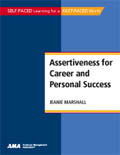Assertiveness for Career and Personal Success
Author: Jeannie Marshall
Credit: 1.0 CEUs
Testing Format: multiple choice
Your Price: $139.00
ISBN: 9780761204664
Format: Audio Compact Disk
Overview
Techniques for managing others while maintaining mutual respect.
Expressing your honest thoughts and feelings to others and asking for—and getting—others to respect your basic rights and needs is not always easy. Assertiveness for Career and Personal Success will help you build on your existing strengths and improve your overall ability to assert yourself in responsible and appropriate ways.
Course Objective: Understand techniques for managing others while maintaining mutual respect and recognize and avoid self-defeating behaviors.
Selected Learning Objectives
• Recognize and avoid seven self-defeating, non-assertive roles
• Manage others without being aggressive or manipulative
• Respond to other people’s needs without giving up your own
• Say “no” to unfair demands
• Resolve conflicts and deal with aggressiveness in others
• Enhance your self-image—and your on-the-job authority
Testing Format
This course contains one multiple choice test valued at one Continuing Education Unit (CEU).
Table of Contents
About the Author
How to Take This Course
PRE-TEST
1. You and Assertiveness 1
Summary
Exhibit 1–1 You and Your Assertiveness
Exhibit 1–2 Indicators of Inappropriate Behavior
Exhibit 1–3 Behavior Modes
Exhibit 1–4 Areas of Assertiveness Difficulty
Exhibit 1–5 Outline of Your Assertiveness Training Program
Exhibit 1–6 Targets for Assertiveness
2. Assertiveness on the Job 13
Summary
Exhibit 2–1 What’s Your Response?
Exhibit 2–2 Analyzing Your Responses
Exhibit 2–3 The Five Main Aims of On-the-Job Assertiveness and Specific Concerns for Each
Exhibit 2–4 Discrimination Exercise
Exhibit 2–5 Career and Personal Goals
Exhibit 2–6 Analyzing Goals
3. You Can Act Assertively 2
Summary
Exhibit 3–1 People Telling You No
Exhibit 3–2 People Asking for Something You Don’t Want
to Give
Exhibit 3–3 Coping with Pressure to Comform
4. Techniques for Becoming More Assertive 3
Summary
Exhibit 4–1 Learning to State Your Desires
Exhibit 4–2 Learning to Say “No”
Exhibit 4–3 Assertive Expressions of Understanding
Exhibit 4–4 More Assertive Expressions of Understanding
Exhibit 4–5 Your Basic Human Rights
Exhibit 4–6 The Endless Tape Technique
5. Your Personal Assertiveness-Building Program 53
Summary
Exhibit 5–1 Subjective Units of Pleasure
Exhibit 5–2 Blocks to Identifying Assertiveness
Exhibit 5–3 Foundations of Your Assertiveness
Exhibit 5–4 Guidelines for Concentrating on Assertiveness
Problem Areas
Exhibit 5–5 Alternative Behavior in Problem Situations
Exhibit 5–6 Setting Goals for Problem Situations
Exhibit 5–7 Evaluating Your New Behavior
Exhibit 5–8 Assertiveness-Building Progress Chart
6. You Can Stop Your Self-Defeating Behavior 69
Summary
Exhibit 6–1 The Underdog
Exhibit 6–2 The Aloof Loaf
Exhibit 6–3 Secret Agent
Exhibit 6–4 Seduction
Exhibit 6–5 Power Behind the Throne
Exhibit 6–6 The Wild Animal
Exhibit 6–7 The Sleeping Giant
Exhibit 6–8 Analyzing Nonassertive Game Playing
7. Assertiveness Guidelines 81
Summary
Exhibit 7–1 Take Responsibility and Stay Focused on Your
Goals
Exhibit 7–2 Body Language Evaluation Sheet
Exhibit 7–3 Practice Choosing Your Responses
Exhibit 7–4 Active Listening Checklist
Exhibit 7–5 Appropriate Levels of Assertiveness
Exhibit 7–6 Summary of Assertiveness Guidelines
8. Assertiveness in Your Everyday Life 91
Summary
Exhibit 8–1 You and Your Assertiveness—Part 2
Exhibit 8–2 Progress in Your Assertiveness Problem Areas
Exhibit 8–3 Progress Toward the Five Main Goals of
Assertiveness on the Job
Exhibit 8–4 Starting Small and Making Progress
Exhibit 8–5 Desensitization and Increased Assertiveness
Exhibit 8–6 Keeping Track of Progress
POST-TEST

